Water activities are so easy to set up and perfect for young kids to play and learn with science. Every day materials and supplies become awesome preschool science experiments. There are tons of ways to investigate water science all year round! Learn about absorption as you investigate what materials absorb water with this fun experiment below.
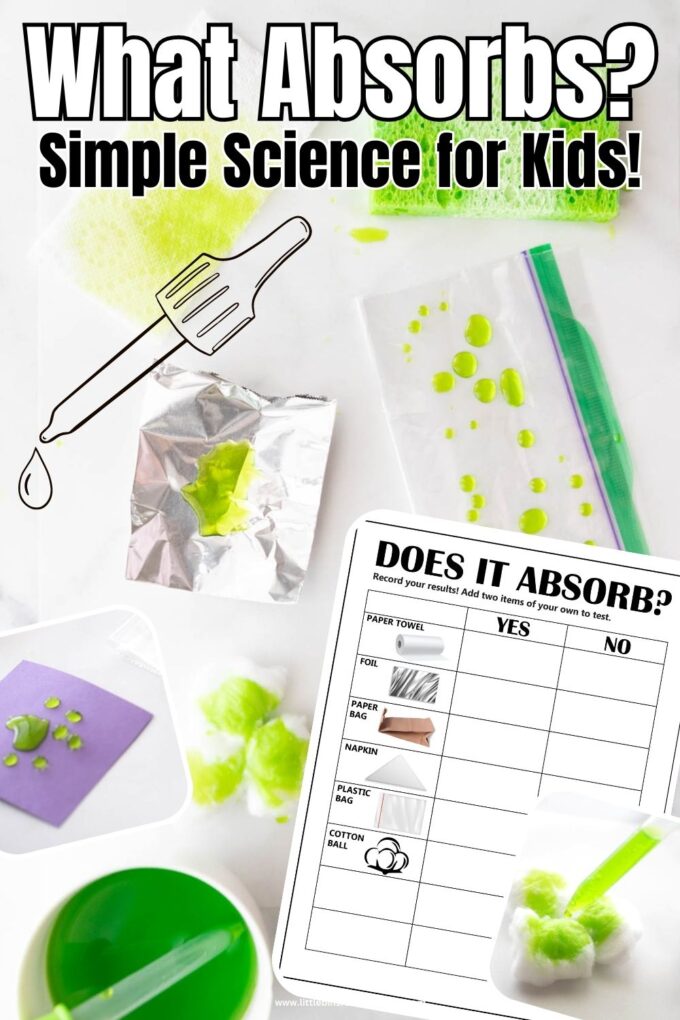
We have played around with cotton pads and water before. Watching the cotton balls fill up with water and then observing what happens to the cotton ball, both wet and dry. A sponge and water also makes for a simple absorption experiment.
This time I decided to make the water absorption experiment a little more challenging by having him guess which materials he thought might absorb the water and which might not.
We talked about how some materials repel water (do not absorb). I had him make some guesses before we started to see what he thought. Time to experiment and observe!
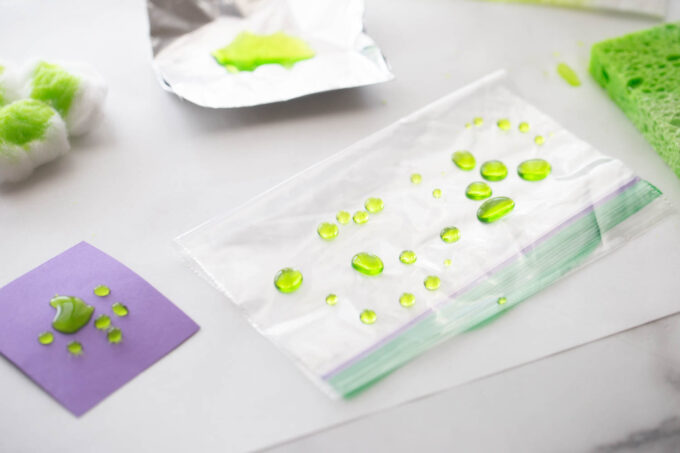
How To Do Science Experiments At Home
Science learning starts early, and you can be a part of that with setting up science at home with everyday materials. Or you can bring easy science experiments to a group of kids in the classroom!
We find a ton of value in cheap science activities and experiments. All our science experiments use inexpensive, everyday materials you can find at home or source from your local dollar store.
We even have a whole list of kitchen science experiments, using basic supplies you will have in your kitchen.
You can set up your science experiments as an activity focusing on exploration and discovery. Make sure to ask kids questions at each step, discuss what is happening and talk about the science behind it.
Alternatively, you can introduce the scientific method, get kids to record their observations, and make conclusions. Read more about the scientific method for kids to help you get started.
Even though the scientific method feels like it is just for big kids…
This method can be used with kids of all ages! Have a casual conversation with younger kiddos or do a more formal notebook entry with older kiddos!
Get your free science process pages!
Water Absorption Experiment
Put the scientific method into practice with this easy to set up science experiment. Extend the activity for older kiddos by changing the independent variable and measuring the dependent variable.
For example, explore what happens if you add the same amount of water to different materials. Or investigate how different fabrics of clothing absorb water.
Watch the Video
SUPPLIES:
I put out the following materials in no particular order for our water science experiment. Free to substitute materials for whatever you have available.
- sponge
- styrofoam tray
- napkin
- wax paper
- sock
- zip lock bag
- paper towel
- sandwich wrap
- construction paper
- aluminum foil
- of course, cotton balls!
- Does it Absorb? (worksheet)
I also set out a bowl of colored water (better to observe with colored water) and an eye-dropper for precise experimentation. Very simple setup. Use what you have in your cupboards, closet, and recycling bin!
YOU MIGHT ALSO LIKE: What Dissolves In Water
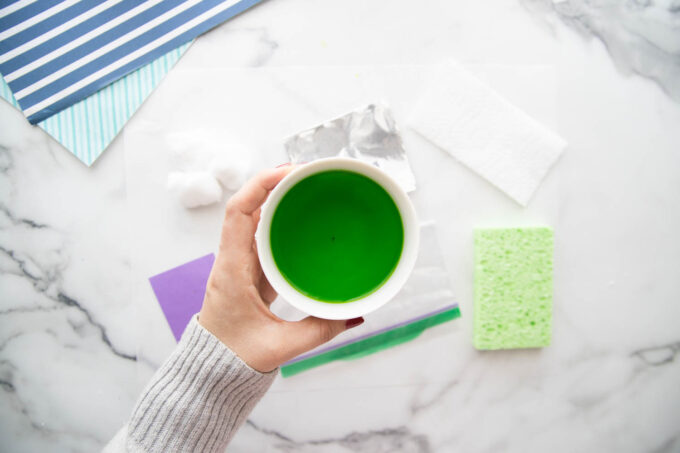
EXPERIMENT SET UP
STEP 1. First, think about which materials might absorb the water and which might repel the water. Make your predictions!
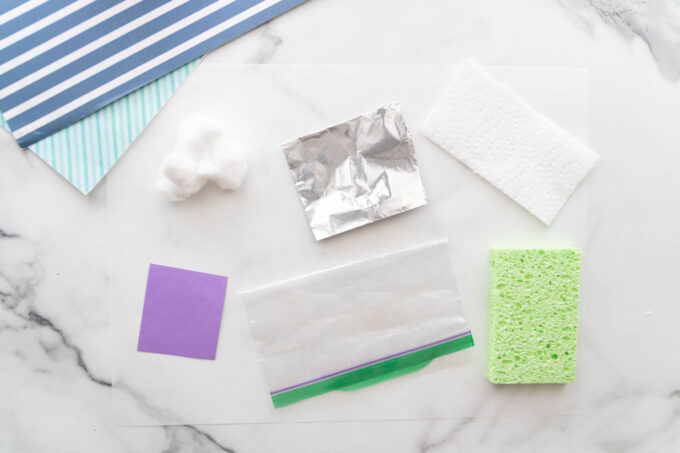
STEP 2. Carefully fill the eye dropper and then squeeze some water onto each material.

Materials That Absorb Water
Here is what we learned! As we tested each item with the water, I asked him what he thought. Did it absorb water? Did it not absorb the water?
He understood the difference, and we had fun checking out what each one did! We can say that absorption is when something takes in another substance.
Materials that absorb water include; a sponge, napkin, paper towel, face cloth, sock, paper, and cotton balls.
Materials that don’t absorb water include; Styrofoam, zip lock bags, wax paper, aluminum foil, and sandwich cling wrap.
The absorption of water is a great example of physical change!
What are the characteristics of materials that absorb water?
Materials that absorb water are described as porous. Porous means capable of absorbing liquids. Porous materials have pores or openings that allow air or water to pass through easily. Materials that repel water or don’t absorb water are called non-porous.
Sponges and cotton are examples of materials found at home that are very porous and absorb water very easily. So if you are cleaning up a spill, grab a cotton rag instead of a polyester shirt.
Plastic cups, metal forks and spoons, ceramic plates are examples of materials found at home that do not absorb water. Which is what you want when you are drinking water or eating food!
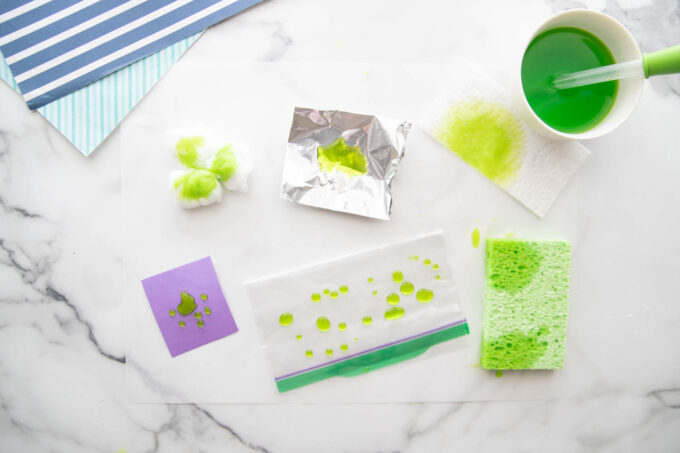
ALSO CHECK OUT: Water Experiments For Kids
He engaged in some free play to wrap up our water absorption experiment. He experimented with different colors, adding more water to different materials and using the sponge to pick up water!

More Fun Water Experiments
There are so many fun ways to explore water science. Here are a few of our favorites…
- What solids dissolve in water?
- Walking Water Experiment
- Why don’t oil and water mix?
- Freezing Water Experiment
- Water Cycle In A Bottle
- Earth Day Water Absorption
Helpful Science Resources
Here are a few resources to help you introduce science more effectively to your kiddos or students and feel confident when presenting materials. You’ll find helpful free printables throughout.
- Best Science Practices (as it relates to the scientific method)
- Science Vocabulary
- 8 Science Books for Kids
- All About Scientists
- Science Supplies List
- Science Tools for Kids
Printable Science Projects For Kids
If you’re looking to grab all of our printable science projects in one convenient place plus exclusive worksheets and bonuses like a STEAM Project pack, our Science Project Pack is what you need! Over 300+ Pages!
- 90+ classic science activities with journal pages, supply lists, set up and process, and science information. NEW! Activity-specific observation pages!
- Best science practices posters and our original science method process folders for extra alternatives!
- Be a Collector activities pack introduces kids to the world of making collections through the eyes of a scientist. What will they collect first?
- Know the Words Science vocabulary pack includes flashcards, crosswords, and word searches that illuminate keywords in the experiments!
- My science journal writing prompts explore what it means to be a scientist!!
- Bonus STEAM Project Pack: Art meets science with doable projects!
- Bonus Quick Grab Packs for Biology, Earth Science, Chemistry, and Physics
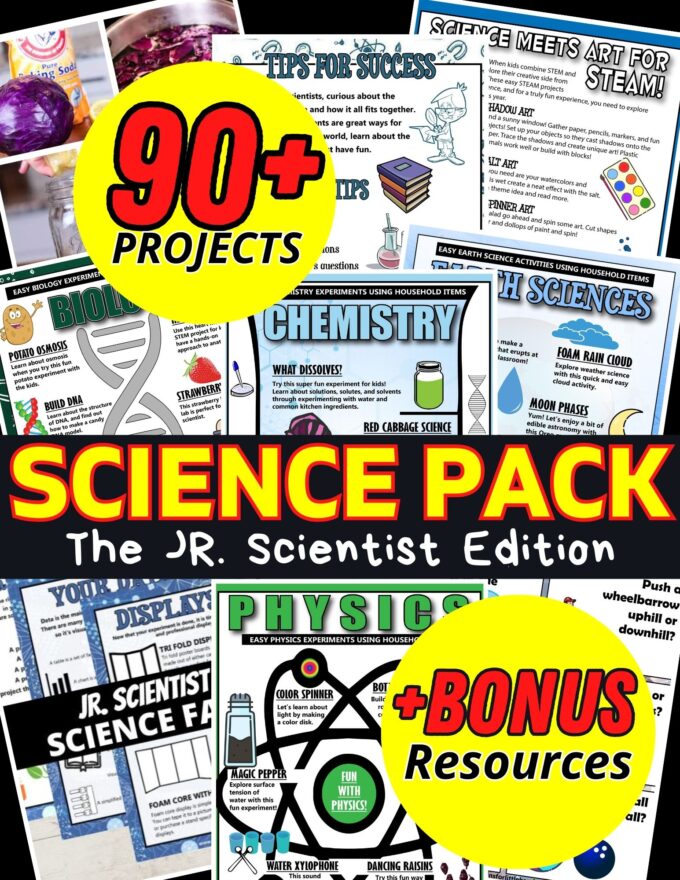
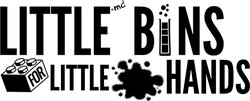

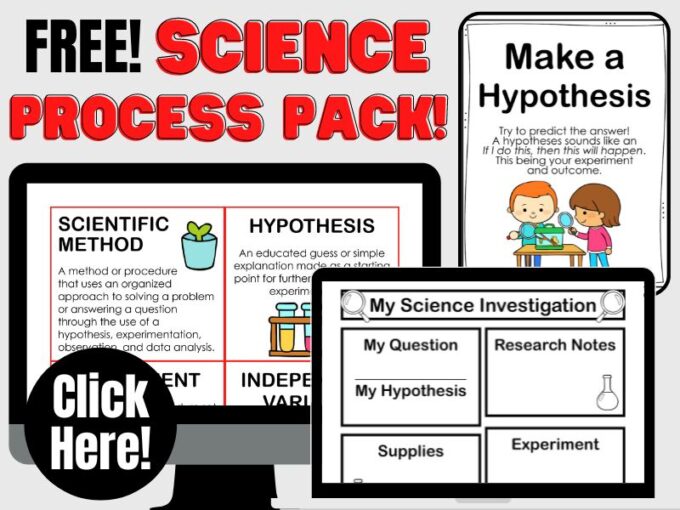
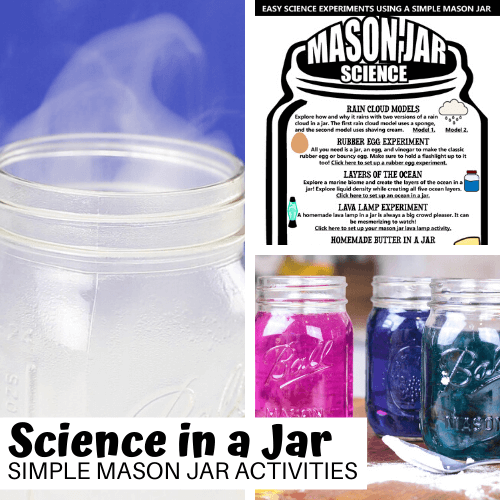
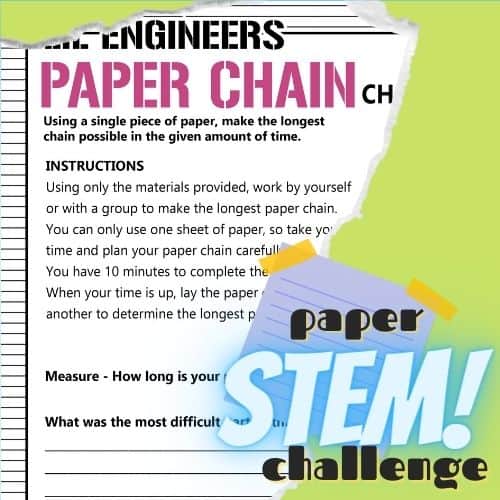
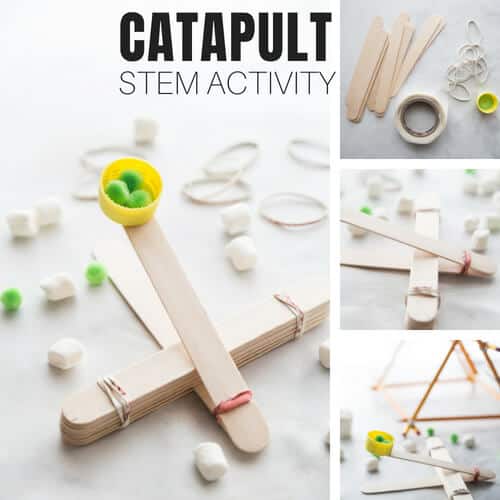
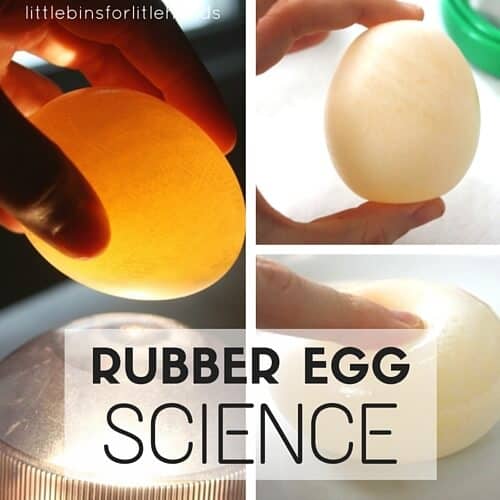
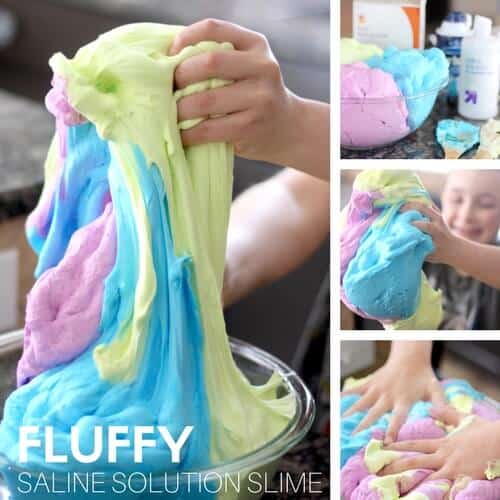
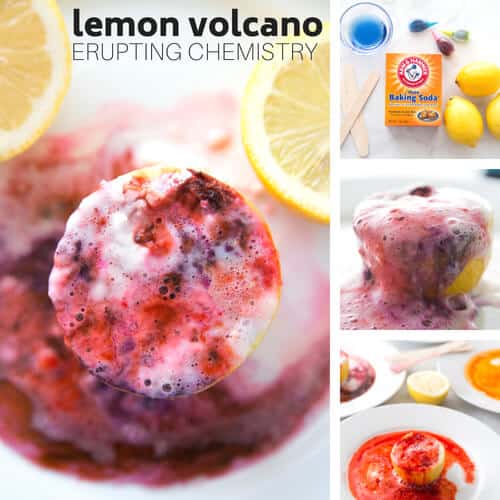
Thanks Emma. I have to be budget friendly and since I never know how long he will be into something I have been leaning towards using what we have around! I could go crazy at the craft store and I shouldn’t!
This is so awesome! I love that you can just use things you have around the house. I’m definitely going to be trying this one. Pinned!
Fantastic! I am a big believer in simple science for preschool, this is a perfect example. I’ve found that listening to children’s questions about how things work is the biggest idea supplier for simple experiment set ups!
I love science experiments and the kids love them so much! Definitely going to be doing this at home with my girls! Thank you for stopping by the Thoughtful Weekly Blog Hop and linking up! You are featured this week as one of my favorites from last weeks hop!
They definitely do! Thank you so much for featuring us! Hope your girls enjoy the experiment
This is so easy my kids would love this! I also. love that you can so this activity with things you have around the house.
i like this expiremant #than you
I was excited to find your blog, because it seemed like you might have some cool things to offer, but the adds on your site are so consuming that I couldn’t even get to your content. It was really overwhelming.
I wish I could share a picture of my screen for you to see. There was literally no space left for any of your actual content to load. Just adds popping up everywhere.
I’m sorry to hear that. I will check with the ad company. Please do keep in mind that in order for me to provide over 1,000 free ideas, I do need to be able to feed my family too! Thanks for the feedback.